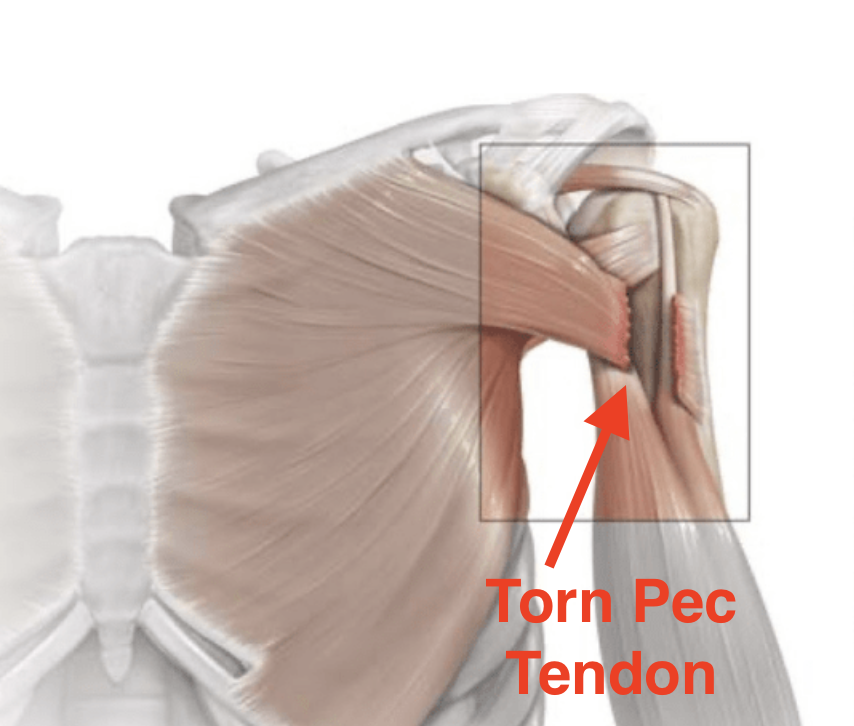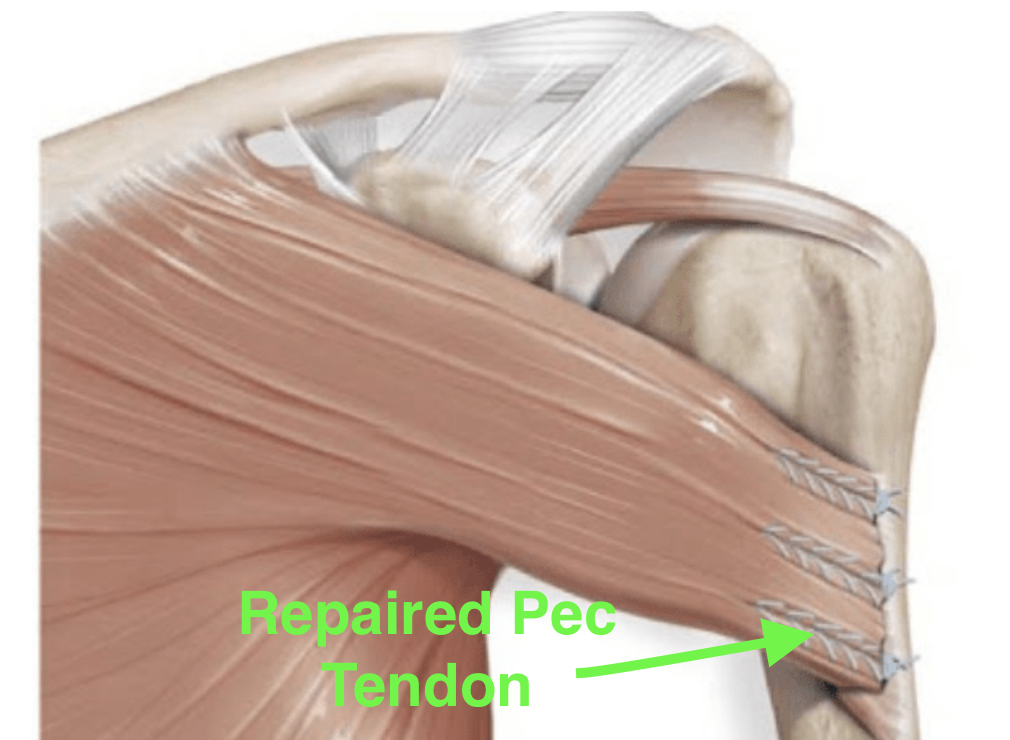Pectoralis "Pec" Tendon Repair Surgery
Your Diagnosis
The Pec tendon connects the large chest muscle, the pectoralis major, to the arm bone. Sometimes it tears. Usually this happens when a person is pushing something heavy as in bench pressing. When this happens many people choose surgery to have the tendon repaired.
What happens during Surgery?
During surgery the torn Pec tendon is repaired back down to the humerus arm bone. Usually this is accomplished using 2 suture anchors through a 2 inch incision in the fold of the armpit (see pictures).
Surgery takes between 45 minutes to 1 hour. It is done with general anesthesia meaning the person is asleep. Usually the person will have a nerve block placed in their neck which makes their shoulder and arm numb for 6 to 24 hours.
Immediately after Surgery
The person will wake up from surgery in the recovery room. If the person had a block then they will notice they cannot feel or move their arm, hand and fingers. This is because of the nerve block and is normal.
After spending 1 to 3 hours in the recovery room the person will be allowed to either go home. In order to go home, they will need a ride, as they cannot drive or take public transportation.
A person may have questions following your surgery. Many of these frequently asked questions about surgery can be answered here.
What to expect after Surgery: Week 0 through Week 6 (Phase One)
- Pain: It is normal for a person to experience moderate to severe pain for the first few days after surgery. A person will be given pain pills to take for the first 5 days after surgery. After that, only Tylenol is recommended (only if the person’s primary doctor says it is safe for them). Pain from the surgery should decrease by roughly half with each passing day.
- Therapy: No shoulder therapy is usually needed for the first 6 weeks. If the person’s hand swells, hand therapy may be started (tight fist protocol).
- Precautions: For the first 6 weeks after surgery, the person should avoid almost all activities with the repaired side. This gives the repaired tendons needed time to heal. If a person actively uses their shoulder before full healing, the surgical repair could pull apart and the person may need another surgery.
Although a person will not be permitted to move their arm/shoulder away from their body, they will still be able to move their elbows and wrists- this means they can still do light things like type, write, cut their food, feed themselves, and wash their face, etc.
The only form of exercise a person should do at this point, is: 1) walk uphill on a paved, even road with their arm in a sling OR 2) ride a stationary bike with their arm in a sling and not holding on to the handle bar.
- Work: People with desk jobs may return to work in a sling within a week after surgery. However they also must follow the above mentioned precautions. People who work manual labor such as construction should not return to work during this period. Anybody who needs one will receive a doctor’s note for their employer.
What to expect after Surgery: Week 6 through Week 12 (Phase Two)
- Pain: It is expected that there will be pain with movement of the shoulder. The pain is usually related to shoulder tightness.
- Therapy: Starting on week 6, if the shoulder is tight the person will begin 4 Quadrant Stretching. They will also begin strengthening the shoulder using a light weight high repetition program.
- Precautions: Starting on week 6 all precautions are lifted except heavy lifting. The person should not lift heavy things until they have strengthened their shoulder.
- The shoulder and arm will be weak at this point since the person has not used the arm for the last 6 weeks. As such the person should use common sense when returning to activities. For example, if the person wants to play golf then start out at the driving range first to see how the shoulder responds -don’t jump into 18 holes with their friends. Or, if the person wants to swim then start out in the shallow end to see how the arm will respond -not the deep end.
- Work: Work should not interfere with the therapy programs. If a person wants to return to work during this period they must find time to stretch and strengthen.
Most people who have jobs that require physical labor are not ready to return to work at the 6 week mark. Some may be ready to go back around week 8-10. It’s unlikely that a person who has a highly physical job will go back to full duty at this time.
What to expect after Surgery: Week 12 through 1 year and beyond (Phase Three)
- Pain: Most people have minimal to no pain.
- Therapy: After week 12 most people will begin to decrease the number of stretches and strengthening exercises they do. They also begin to return to normal activities. Their function will gradually improve over the year.
- Precautions: Usually by the 12 week mark, a person is doing about 80% of the kind of activity and exercise they were doing prior to surgery. It is important to note, that most people will continue to improve for at least 1 to 1 1/2 years after surgery.
- Work: Most people have returned to work.

